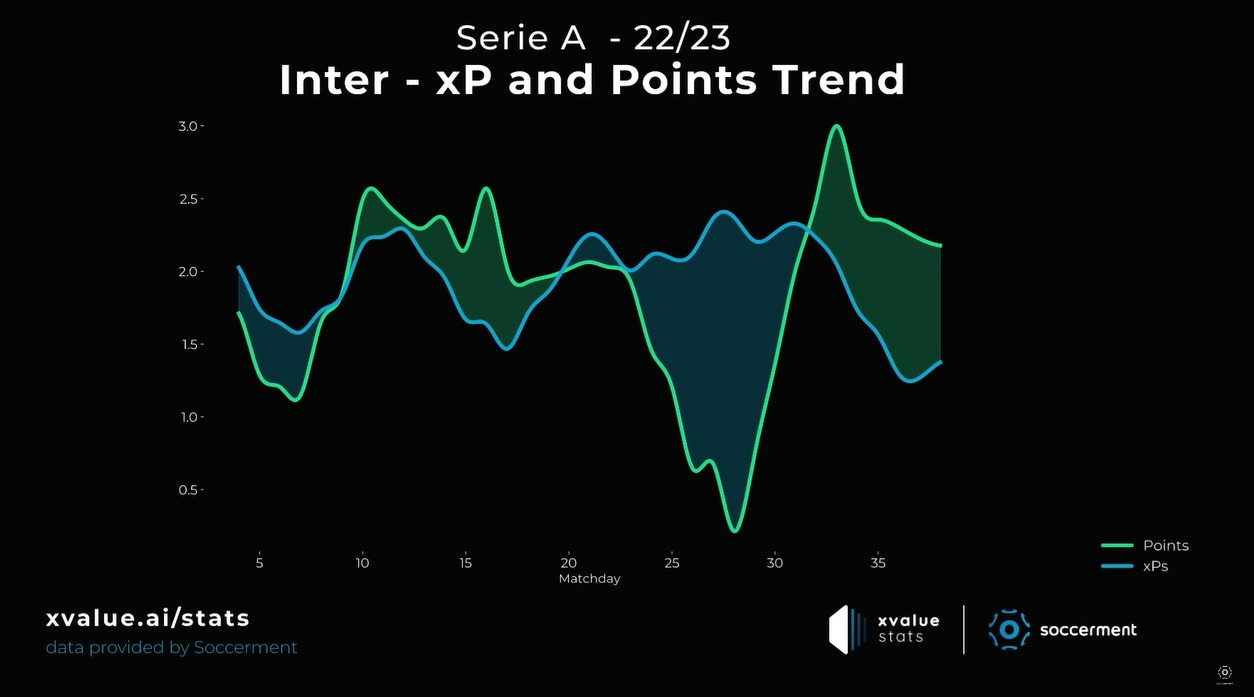How a Once-in-a-Lifetime Upset Strengthened My Faith in Football Data
The underdog, Spezia, faced giants Inter and, against all odds, emerged victorious. But beyond the upset, this match reinforced my trust in football data analytics.
The Game That Defied Expectations
In the 26th Gameweek of Serie A, Internazionale Milano faced Spezia, a club renowned for their effective use of data analysis, making them one of the few Italian clubs to embrace this approach. Prior to this match, Inter was going through a turbulent phase, struggling to secure consistent wins at home and dropping points on their travels.
On paper, Inter was poised to dominate. Their shots outnumbered Spezia's, the expected goals (xG) were heavily in their favor, and yet, football once again proved its unpredictability. Inter managed only a solitary goal, and that too from the penalty spot.
According to FBref, Inter generated an impressive 3.8 expected goals (xG) while Spezia managed just 1.0 xG. Inter’s misfortune included a missed penalty, whereas Spezia capitalized on a penalty opportunity
Despite Spezia managing only four shots, including a penalty, their expected goals (xG) totalled 0.99. These shots included one from a close angle and two others with relatively low quality chances.
On the other hand, Inter’s offensive efforts were noteworthy. They created a staggering 28 shots, many of which were high-quality chances with a substantial xG per shot. However, Inter struggled to convert these opportunities, scoring only one goal from the penalty spot and missing another.
Spezia’s goalkeeper had an outstanding performance, making crucial saves that contributed significantly to his team’s 3 crucial points, which ultimately played a role in their fight to avoid relegation. It’s worth noting that Spezia eventually had to participate in a playoff but unfortunately got relegated.
The high xG of 3.87 for Inter, despite being on the losing side, adds another layer of intrigue to this game. It underscores the notion that sometimes football outcomes can be unpredictable, with strong statistical indicators not always translating into victory. This match exemplifies the captivating and occasionally perplexing nature of football analytics, where data can tell a story that goes beyond the final score.
It’s indeed strange that Inter ended up losing the game, but what makes it even more intriguing is that only Inter managed to find the net from the penalty spot. Consider the fact that Inter had a substantial 3.8 expected goals (xG), yet they could only convert one goal from a penalty kick. On the other hand, Spezia, with an xG of 1.0, managed to score two goals, one of which came from a penalty. This equates to an xG conversion rate of 0.79 for Spezia.
These statistics highlight the unusual and unpredictable nature of this particular game.
The Underlying Numbers Tell a Deeper Story
From the 26th to the 30th gameweek, they only managed to secure one point, a stark contrast to the expected 11 points during this period. While we can debate various factors affecting these results, the match against Spezia stands out.
Examining the graph, it becomes evident that Inter encountered a challenging phase from the 25th gameweek to the 30th gameweek, during which they obtained fewer points than expected based on their performance. However, following this period, they exceeded the expected points, highlighting the significance of underlying statistical indicators in influencing future results.
Even during a subsequent losing streak, with Inter losing three out of the next four matches and only managing a single point out of 12, maintaining a calm perspective was crucial. While some fans may have called for the manager’s dismissal, it’s important to recognize that football is a complex sport, and fluctuations in performance are not uncommon.
Football is a sport that stirs emotions, often dramatically, but when coupled with statistical analysis and data-driven insights, it offers a more comprehensive understanding of what transpired on the field and what can be expected in the future. The blend of passion and data enriches the fan experience and allows for a deeper appreciation of the intricacies of the beautiful game.
Data analytics in football remains an invaluable tool for analyzing the sport, particularly in scenarios that might seem unusual or unexpected.
In Data We Trust
As a devoted Inter fan with a keen interest in the numbers, this game was undoubtedly a shock. However, upon closer examination, it became apparent that the team gave their all, and sometimes, despite strong efforts, unpredictable outcomes can occur.
This match served as a personal epiphany. While the sting of defeat hurt, the underlying numbers were encouraging, offering a less emotional, more analytical judgment. It was evidence that while teams may underperform and miss their targets, data remains a good indicator of potential.
Checking websites that use data to predict teams’ final league position, such as ”thirtyfiveeight” provided valuable insights, with many of them consistently projecting Inter to finish in the top 4.
The world of football is ever-volatile, and outcomes like this match between Spezia and Inter reaffirm the value of data analytics. It teaches us to look beyond the scoreboard and appreciate the subtle, yet powerful narratives woven through numbers and statistics. And as I delved deeper into the data, my conviction only grew—sometimes, the game's true beauty lies in the spreadsheets and databases, waiting to be deciphered.
NB: Always remember, even when your favorites falter, data will help you understand the why and how, guiding you to better assess and predict the beautiful game's flow.




